The Summary tab on the tabbed window displays summary information about file visit counts. This is known as the summary view.
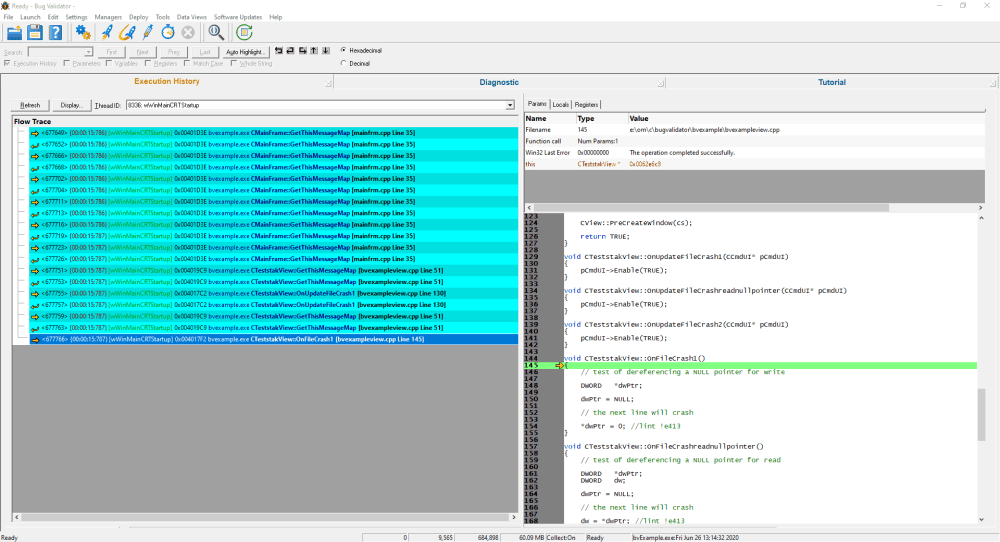
The execution history display is split into two panes. The left hand pane is a tree control showing the execution history lines, the right hand pane displays the parameters, local variables, registers and source code for a particular line. The tree control when expanded shows a small code fragment for the particular line.
Each line displays the thread ID, the DLL name, the program counter, the source file name and the line number for the source file. When multiple threads are displayed, each time the thread ID changes, the background colour for the lines is changed, so that changing execution context is easy to see on the display.
Parameters, local variables and registers are shown in a tabbed window above the source code.
Controls
The file and line controls are shown below.

Refresh
To refresh the display click the Refresh button.
Thread ID
The Thread ID combo box lists the ID of each thread. You can show the execution history for an individual thread by selecting the thread ID. To show the execution history for all threads, choose All threads. When displaying the execution history for all threads, the execution history shows the order in which each thread swaps in and out of the thread scheduling, this is highlighted by a change in the background colour for each thread.
DLL name
To have the DLL name shown in the execution history, select the DLL name check box.
DLL path
To have the full path to the DLL shown in the execution history, select the DLL path check box.
Function name
To show the encoded function name in the execution history, select the Function name check box.
File path
To show the encoded file name in the execution history, select the Function name check box.
Id
To show the history id in the execution history, select the Id check box.
Thread Id
To show the thread id in the execution history, select the Thread Id check box.
Function Calls
To display information about function calls, select the Function Calls check box.
Line execution
To display information about line execution, select the Line execution check box.
Exceptions
To display information about exceptions, select the Exceptions check box.
Function returns
To display information about function returns, select the Function returns check box.
Search
The search toolbar can be used to search for data in the execution history. Data can also be automatically highlighted by using the Advanced... button.

To search for data in the execution history the Search field and the First, Next, Prev, Last buttons are used. Previous search texts are remembered in the combo box for easy reuse. The history for search texts is 30 items.
The Match Case and Whole String check boxes affect the pattern matching of the search. Selecting the Match Case check box makes text searches case sensitive. Deselecting the Match Case check box makes text searches case insensitive. Selecting the Whole String check box makes text searches match the entire string. Deselecting the Whole String check box makes text searches match the partial strings.
The Execution History, Parameters, Variables, Registers check boxes control which data areas are searched for a text match.
The Hexadecimal and Decimal radio boxes control the display of Parameters, Variables and Registers in hexadecimal and decimal format, repectively.
The navigation buttons provide the following functionality:
 Go to caller.
Go to caller.
 Go to after caller.
Go to after caller.
 Step into.
Step into.
 Previous line.
Previous line.
 Next line.
Next line.
Auto Highlight
The Auto Hightlight... button displays the Auto Highlight dialog.
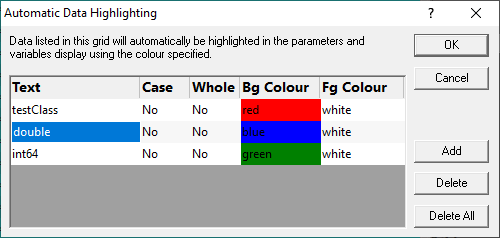
Data matching the search criteria for each item in the auto highlight dialog is highlighted in the data display above the source code window.
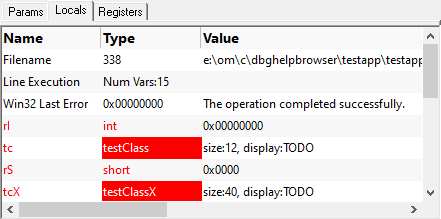
The columns in the Automatic Data Highlighting dialog are as follows:
•Text. The text to search for.
•Case. Yes if the search is case sensitive. No if the search is case insensitive.
•Whole. Yes if the text is the entire string. No if the text is a partial match.
•Bg Colour. The background colour for any matching data display.
•Fg Colour. The foreground colour for any matching data display.
The controls are:
•Add. Click Add to add an item. Click on each field to edit the contents. The text field is an edit box. The other fields are combo boxes.
•Delete. Select one or more items, and click Delete to delete the items.
•Delete All. Click Delete All to delete all items.
Context Menu
The execution history display provides a context menu.
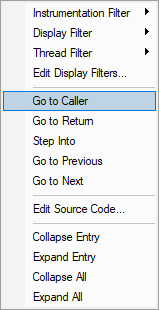
Instrumentation Filter
The instrumentation filter allows you to prevent various files from being instrumented the next time the application is executed.

Filename. To add the filename of the selected item to the list of files to exclude from instrumentation select the Filename option.
Directory. To add the directory of the selected item to the list of files to exclude from instrumentation select the Directory option.
DLL. To add the DLL of the selected item to the list of files to exclude from instrumentation select the DLL option.
Display Filter
The display filter allows you to control the information displayed on the execution display.
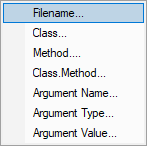
Filename... To filter using the selected item's filename choose the Filename option.
Class... To filter using the selected item's class name choose the Class option.
Method... To filter using the selected item's method name choose the Method option.
Class.Method... To filter using the selected item's class name and method name choose the Class.Method option.
Argument Name... To filter using the selected item's argument name choose the Argument Name option.
Argument Type... To filter using the selected item's argument type choose the Argument Type option.
Argument Value... To filter using the selected item's argument value choose the Argument Value option.
Edit Display Filters...
To edit the list of display filters choose Edit Display Filters.
Go to Caller
Move the current item to the caller of this item.
Go to Return
Move the current item to the return from this item.
Step Into
Move the current item to the first child item of this item.
Go to Previous
Move the current item to the previous item.
Go to Next
Move the current item to the next item.
Edit Source Code...
Edit the source code of this item.
Refresh
Refresh this display with the current data.
Refresh All
Refresh all displays.
Collapse Entry
Collapse this entry.
Expand Entry
Expand this entry.
Collapse All
Collapse all entries.
Expand All
Expand all entries.